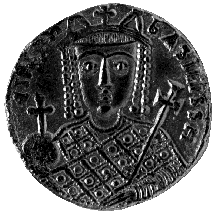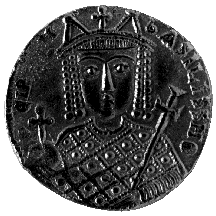



(142) Irene - AV solidus, A.D. 797-802, 4.37 g. (inv. 91.283).
Obverse: Facing bust of Irene, wearing loros and crown with cross
and holding cross scepter in l. and globus cruciger in r.; EIRINH
bASILISSH: Queen Eirene.
Reverse: Same
Provenance: Numismatic Fine Arts, 1979.
Bibliography: P. Grierson, Byzantine Coins (London 1982).
When Leo IV died in A.D. 780, his son, Constantine VI, was made emperor,
but since he was only ten years old the empress Irene was made co-emperor.
As Constantine grew older, more independent, and reckless, he and his mother
struggled for power, and Irene finally had him blinded and deposed. She
then became the first Byzantine empress to rule in her own right. She was
deposed by Nicephorus I and sent into exile.
Irene was diplomatically and fiscally inept, but she made her mark by rejecting
iconoclasm, the official condemnation of the cult of icons, for which she
was eventually made a saint of the Orthodox Church. Her reform was short-lived,
however, for iconoclasm was reinstated after her deposition. Although in
her brief reign religious images were once again permitted, she did not
attempt to put them on her coins. Since she could not claim dynastic connections
to the emperor she had deposed, she put her own portrait on both the obverse
and reverse of her coins. She wears the full imperial dress, including the
loros and the characteristic crown of empresses, which has pyramidal
spikes and very long prependulia or ornamental chains.
R.K.B.



All contents copyright (c) 1996.
Lawrence University
All rights reserved.